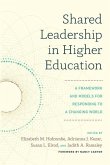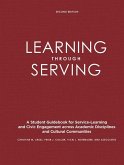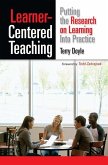Ann Wolverton, Lisa Nagaoka, Mimi Wolverton
Breaking in
Women's Accounts of How Choices Shape Stem Careers
Ann Wolverton, Lisa Nagaoka, Mimi Wolverton
Breaking in
Women's Accounts of How Choices Shape Stem Careers
- Broschiertes Buch
- Merkliste
- Auf die Merkliste
- Bewerten Bewerten
- Teilen
- Produkt teilen
- Produkterinnerung
- Produkterinnerung
Why is it that, in proportion to the PhDs they obtain in STEM, they attain fewer administrative and managerial positions in academia and industry than their numbers warrant and, moreover, are more likely leave the field once started in their careers?
Andere Kunden interessierten sich auch für
![Shared Leadership in Higher Education Shared Leadership in Higher Education]() Nancy CantorShared Leadership in Higher Education46,99 €
Nancy CantorShared Leadership in Higher Education46,99 €![The Handbook of International Higher Education The Handbook of International Higher Education]() Francisco MarmolejoThe Handbook of International Higher Education90,99 €
Francisco MarmolejoThe Handbook of International Higher Education90,99 €![Becoming a White Antiracist Becoming a White Antiracist]() Stephen D. Brookfield (USA. Columbia University)Becoming a White Antiracist36,99 €
Stephen D. Brookfield (USA. Columbia University)Becoming a White Antiracist36,99 €![Learning Through Serving Learning Through Serving]() Christine M CressLearning Through Serving198,99 €
Christine M CressLearning Through Serving198,99 €![Learner-Centered Teaching Learner-Centered Teaching]() Terry DoyleLearner-Centered Teaching40,99 €
Terry DoyleLearner-Centered Teaching40,99 €![The Learner-Centered Instructional Designer The Learner-Centered Instructional Designer]() Jerod QuinnThe Learner-Centered Instructional Designer48,99 €
Jerod QuinnThe Learner-Centered Instructional Designer48,99 €![Introduction to Rubrics Introduction to Rubrics]() Dannelle D. StevensIntroduction to Rubrics189,99 €
Dannelle D. StevensIntroduction to Rubrics189,99 €-
-
-
Why is it that, in proportion to the PhDs they obtain in STEM, they attain fewer administrative and managerial positions in academia and industry than their numbers warrant and, moreover, are more likely leave the field once started in their careers?
Produktdetails
- Produktdetails
- Verlag: Stylus Publishing
- Seitenzahl: 256
- Erscheinungstermin: 17. Dezember 2014
- Englisch
- Abmessung: 226mm x 150mm x 28mm
- Gewicht: 328g
- ISBN-13: 9781579224295
- ISBN-10: 1579224296
- Artikelnr.: 41027791
- Verlag: Stylus Publishing
- Seitenzahl: 256
- Erscheinungstermin: 17. Dezember 2014
- Englisch
- Abmessung: 226mm x 150mm x 28mm
- Gewicht: 328g
- ISBN-13: 9781579224295
- ISBN-10: 1579224296
- Artikelnr.: 41027791
Ann Wolverton graduated from the University of Texas at Austin (UT) in 1999 with a PhD in economics. Her 1993 entering class consisted of roughly 30 students, four of whom were women; and no tenure-track women were on UT's economics faculty at the time. Most of the women who started the program finished it. As Ann puts it, "We were a stubborn bunch." Ann served two terms (2007 and 2009) on the Council of Economic Advisers to the President as the senior economist for environment and natural resources. She currently works as an economist for the federal government. Lisa Nagaoka graduated from the University of Washington's PhD program in anthropology program in 2000, specializing in archeology. During much of her time there was a lone female professor on Washington's faculty; and she was the only archaeology professor with children. She notes that, at one time, the archaeology graduate student population was mostly female, two women to every man. The attrition rate for women, however, was twice that of their male counterparts. Lisa has established herself as an international expert in zooarchaeology with a focus on human-environment interactions. Today, she is the sole tenured woman faculty member in the Geography Department at the University of North Texas. Mimi Wolverton graduated from Northern Illinois University with an undergraduate degree in mathematics and a minor in geology in 1967. She encountered no women on the faculty in either department. That year, women in STEM disciplines (science, technology, engineering, and mathematics) accounted for 8 percent of PhDs. and less than 25 percent of baccalaureate degrees. After working a number of years in heavy construction, she earned both an MBA and a PhD in education leadership and policy studies at Arizona State University and spent several years in academia, retiring in 2007 as a full professor.
Preface Acknowledgments 1. The Realities of Breaking In 2. Fascination, Fun, and Flexibility
Cynthia Barnhart 3. A Curious Mind
Linda S. Birnbaum 4. The Consummate Professor
Susan Blessing 5. Academia. A Good Fit
Teresa D. Golden 6. A Life Full of Serendipitous Options
Sharon Hays 7. Enjoying a Life That Fits
Angela Hessler 8. An Ardent Adventurer
Bonnie F. Jacobs 9. Just Happened To Be In the Right Place at the Right Time, and Incredibly Bright
Radia Perlman 10. The Realities of Choice 11. Is the Past the Present? 12. Hidden Choices 13. Choices. Is The Past the Future? Appendix. Web
Based STEM
Related Resources for Girls and Women Index
Cynthia Barnhart 3. A Curious Mind
Linda S. Birnbaum 4. The Consummate Professor
Susan Blessing 5. Academia. A Good Fit
Teresa D. Golden 6. A Life Full of Serendipitous Options
Sharon Hays 7. Enjoying a Life That Fits
Angela Hessler 8. An Ardent Adventurer
Bonnie F. Jacobs 9. Just Happened To Be In the Right Place at the Right Time, and Incredibly Bright
Radia Perlman 10. The Realities of Choice 11. Is the Past the Present? 12. Hidden Choices 13. Choices. Is The Past the Future? Appendix. Web
Based STEM
Related Resources for Girls and Women Index
Preface Acknowledgments 1. The Realities of Breaking In 2. Fascination, Fun, and Flexibility
Cynthia Barnhart 3. A Curious Mind
Linda S. Birnbaum 4. The Consummate Professor
Susan Blessing 5. Academia. A Good Fit
Teresa D. Golden 6. A Life Full of Serendipitous Options
Sharon Hays 7. Enjoying a Life That Fits
Angela Hessler 8. An Ardent Adventurer
Bonnie F. Jacobs 9. Just Happened To Be In the Right Place at the Right Time, and Incredibly Bright
Radia Perlman 10. The Realities of Choice 11. Is the Past the Present? 12. Hidden Choices 13. Choices. Is The Past the Future? Appendix. Web
Based STEM
Related Resources for Girls and Women Index
Cynthia Barnhart 3. A Curious Mind
Linda S. Birnbaum 4. The Consummate Professor
Susan Blessing 5. Academia. A Good Fit
Teresa D. Golden 6. A Life Full of Serendipitous Options
Sharon Hays 7. Enjoying a Life That Fits
Angela Hessler 8. An Ardent Adventurer
Bonnie F. Jacobs 9. Just Happened To Be In the Right Place at the Right Time, and Incredibly Bright
Radia Perlman 10. The Realities of Choice 11. Is the Past the Present? 12. Hidden Choices 13. Choices. Is The Past the Future? Appendix. Web
Based STEM
Related Resources for Girls and Women Index








